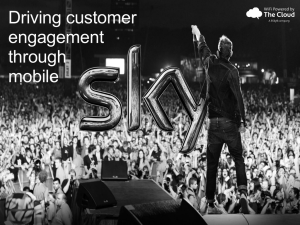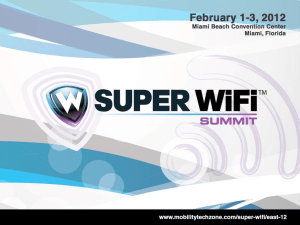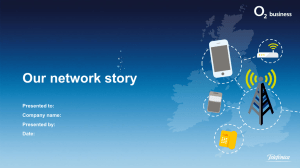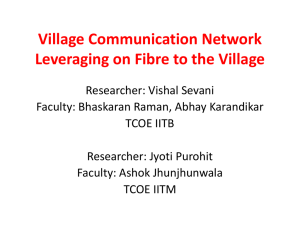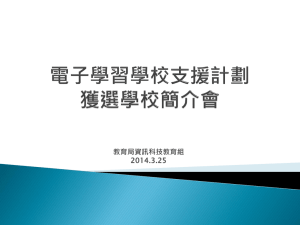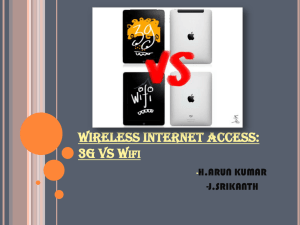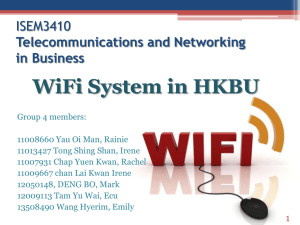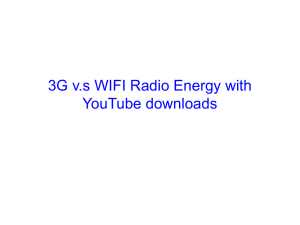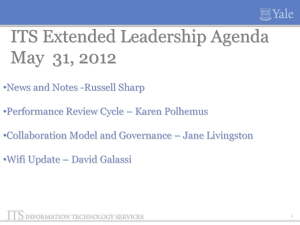Document
advertisement
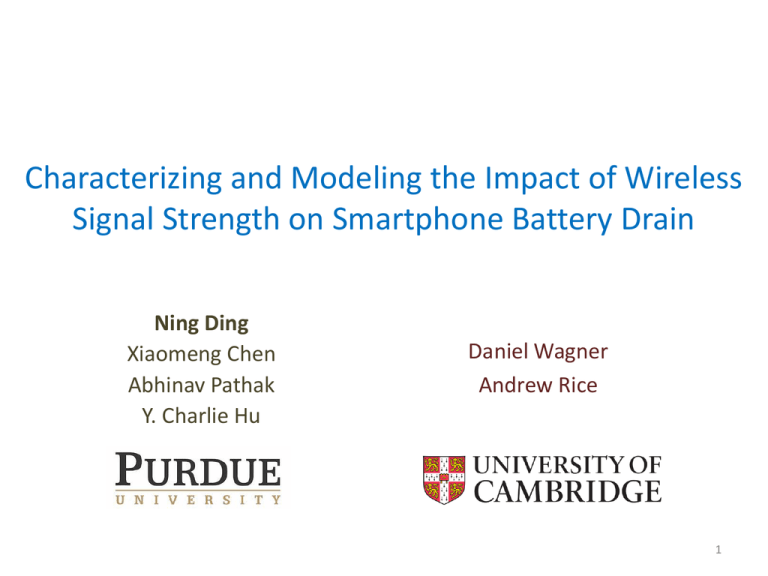
Characterizing and Modeling the Impact of Wireless Signal Strength on Smartphone Battery Drain Ning Ding Xiaomeng Chen Abhinav Pathak Y. Charlie Hu Daniel Wagner Andrew Rice 1 Mobile Networks Connect the World 2 Signal Strength Affects User Experience Ideally Reality… 3 Complaints about Poor Signal 4 Key Questions about the Impact of Signal Strength • How often are users experiencing poor signal? • How much is the impact on battery drain? • How do we model the extra energy drain? 5 Key Questions about the Impact of Signal Strength • How often are users experiencing poor signal? • How much is the impact on battery drain? • How do we model the extra energy drain? 6 Signal Strength Trace Collection Your phone changes network cell 213 times per day 62% of your phone calls are less than 30s You transfer 3.7MB per day with WiFi, and 1.5MB per day with 3G Your average charging time is 42min If the user permits, the app will upload anonymous signal strength and location data 7 Data Contributors Contributors: ■ 1-10 ■ 11-100 ■ 101-1000 Traces (> 1 month) from 3785 users, 145 countries, 896 mobile operators 8 Distribution of Wireless Technologies 100 sampled devices WiFi 40% HSPA 42% UMTS 8% None 8% EDGE 2% 9 Distribution of Wireless Technologies WiFi and 3G (HSPA, UMTS) are the dominant wireless technologies 10 3G Signal Strength Distribution Poor signal ≤ -91.7dBm [defined by Ofcom] Empty bar ≤ -109dBm Full bar ≥ -89dBm On average users saw poor 3G signal 47% of the time 11 Data Transferred under 3G 43% of 3G data are transferred at poor signal 12 WiFi Signal Strength Distribution Full bar ≥ -55dBm Poor signal ≤ -80dBm Empty bar ≤ -100dBm On average users saw poor WiFi signal 23% of the time 13 Data Transferred under WiFi 21% of WiFi data are transferred at poor signal 14 Possible Reasons for Signal Strength Variations A user with good 3G signal 15 Possible Reasons for Signal Strength Variations A user with medium 3G signal A user with poor 3G signal 16 Summary of Signal Strength Distribution • Users spend significant amount of time in poor signal strength – 47% of time in 3G – 23% of time in WiFi • A large fraction of data are transferred under poor signal strength – 43% of data in 3G – 21% of data in WiFi 17 Key Questions about the Impact of Signal Strength • How often are users experiencing poor signal? • How much is the impact on battery drain? • How do we model the extra energy drain? 18 Smartphones Used in Experiments HTC Nexus One Motorola Atrix 4G Sony Xperia S 802.11b/g 802.11b/g 802.11b/g T-Mobile 3G AT&T 3G AT&T 3G Results shown are for Nexus One phone 19 WiFi Experiment Setup Local server: runs socket server, emulates RTT using tc Powermeter Control signal strength by adjusting the distance Wireless router: connects to server with 100Mbps LAN Phone: performs 100KB socket downloading Laptop1: monitor mode, captures all MAC frames Laptop2: monitor mode, captures all MAC frames 20 WiFi Experiment Results -90dBm: 13x longer flow time, 8x more energy, compared to -50dBm Flow time and energy for 100KB download with 30ms server RTT 21 WiFi Energy Breakdown Methodology Power profile from powermeter Packet send Packet recv A snapshot of synchronized power profile and packet trace Packet traces from laptops 22 WiFi Energy Breakdown Energy breakdown 23 WiFi Energy Breakdown Analysis Data rate Leads to higher Rx energy Retransmission rate Leads to higher reRx and idle energy 24 3G Experiment Setup Local server: runs socket server, emulates RTT using tc, run TCPDump to capture packets Powermeter Control signal strength by changing location of the phone Phone: performs 100KB socket downloading, run TCPDump to capture packets 25 3G Experiment Results -105dBm: 52% more energy, compared to -85dBm Flow time and energy for 100KB download with 30ms server RTT 26 3G Energy Breakdown Methodology T-Mobile 3G state machine 27 3G Energy Breakdown -105dBm: 184% more energy on Transfer, 76% more energy on Tail1, compared to -85dBm Energy breakdown 28 Key Questions about the Impact of Signal Strength • How often are users experiencing poor signal? • How much is the impact on battery drain? • How do we model the extra energy drain? 29 Smartphone Energy Study Requires Power Models Smartphone Powermeter Power Output • Not convenient to use • Cannot do energy accounting 30 Train Power Models Correlation between the triggers and energy consumption Triggers Power Model 31 Use Power Models Triggers Power Model Predicted power • Eliminates the need for powermeter • Enables energy accounting 32 Three Generations of Smartphone Network Power Models Network states Subroutinelevel energy accounting Power Model Trigger Overhead Utilizationbased Bytes sent/received Low Packet-driven Packets High System-call driven System calls Low Incorporate the impact of signal strength 33 Refine WiFi Packet-driven Power Model Refine the model by deriving state machine parameters under different WiFi signal strength WiFi power state machine under good signal strength 34 Refine 3G Packet-driven Power Model Refine the model by deriving state machine parameters under different 3G signal strength 3G power state machine under good signal strength 35 Refine System-call-driven Power Models • Incorporate impact of signal strength on – State machine parameters – Effective transfer rate • Details are in the paper 36 Evaluation of New System-call-driven Power Models 61.0% 52.1% 5.4% Model accuracy under WiFi poor signal (below -80dbm) 7.2% Model accuracy under 3G poor signal (below -95dbm) 37 Conclusion • The first large scale measurement study of WiFi and 3G signal strength – Time under poor signal: 47% for 3G, 23% for WiFi – Data under poor signal: 43% for 3G, 21% for WiFi • Controlled experiments to quantify the energy impact of signal strength – WiFi: 8x more energy under poor signal (-90dBm) – 3G: 52% more energy under poor signal (-105dBm) • Refined power models that improve the accuracy under poor signal strength – WiFi: reduce error rate from up to 61.0% to up to 5.4% – 3G: reduce error rate decreases from up to 52.1% to up to 7.2% 38

